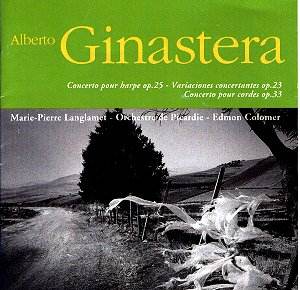Is Ginastera as popular as he ought to be? He is reasonably
represented in the record catalogue (though his operas are noticeably
absent) but I can't help feeling that his music ought to be more popular
than it is. Perhaps he has the misfortune to be still regarded as a
Nationalist composer, at best a sort of Argentinian Bartók. His
music has gone through distinct phases, starting with works in a purely
nationalistic folk-idiom he gradually absorbed and sublimated the folk
material. Experimenting with serialism in the 1950s, his style developed
into something unique which, whilst still owing something to his Argentinian
roots, is worlds apart from kitsch folkloric extravaganzas.
The Harp Concerto was written in 1956 but only
received its first performance in 1965 when Nicanor Zabaleta performed
it with the Philadelphia Orchestra under Eugene Ormandy. An attractive
work which flirts with dissonance whilst remaining attractively melodic,
it is well scored so that the harp is never overwhelmed by the orchestra.
In the first movement, highly rhythmic sections on the full orchestra
alternate with rather more rhapsodic episodes which allow the harp to
shine. It concludes with a surprisingly quiet finale. This leads in
to the rather Bartókian slow movement. The rather angular melodic
material, hauntingly played, creates an atmospheric movement. This leads,
via a surprisingly low key cadenza, into the finale which is driven
along by the underlying syncopated rhythms. The Orchestra de Picardie
respond very well to Ginastera's taut rhythms and harpist Marie-Pierre
Langlamet relishes the opportunities that Ginastera gives her. It is
not a bravura work, but the solo parts contains much that is subtle
and attractive.
In the Variaciones Concertantes, written
in 1953, we reach one of Ginastera's most well known and attractive
orchestral works. In the composer's own take on concerto grosso form,
a series of 12 variations on an original theme provide solo opportunities
for most of the section principals in the orchestra. The harp and cello
introduce the theme in a prelude suffused with warm Latin light, the
composer then carefully shapes the different variations so that the
resulting work has a satisfactory shape, concluding with a rousing rondo,
a sort of South American fiesta. All the principals play well and the
different variations show the orchestra off well, though there was the
odd moment of uncertain tuning. The most virtuoso variations are probably
the giocoso flute one and the clarinet scherzo, but the horns have a
striking pastorale moment and the trumpet and trombone a rather rhythmic
one.
The Concerto for Strings was written for Ormandy
and the Philadelphia Orchestra and was premiered in 1966. Ginastera's
style had developed, during the late 1950s and 1960s he had been writing
music in his own, distinctive brand of serialism. The composer himself
described the 'Concerto for Strings' as belonging to his neo-expressionist
period. Like the Variaciones Concertantes the concerto calls
for a solo quintet (2 violins, viola, cello and double-bass) to contrast
with the main body of the strings. This is tougher music than the other
two pieces on this disc. And lacking woodwind and brass, it does not
have the attractive gloss which Ginastera's brilliant orchestration
gives. But it is a strong piece and given a fine performance here. It
begins with a series of variations for each of the members of the solo
quintet. The cadenza-like theme is stated first by the first violin
and incorporates quarter tones. The second movement is the suitably
titled Scherzo Fantastico. The slow movement is a beautifully anguished
Adagio which leads to a hard-driven, fast and furious finale. This is
strong music and at times the strings of the Orchestre de Picardie seemed
a little stretched, but they give a tremendous performance and their
lean tone suits this masterly work. I Musici di Montreal on Chandos
have the benefit of a somewhat clearer recording and give a technically
brilliant performance. But their disc is devoted simply to string music
from a variety of composers, rather than the current discís rather illuminating
survey of Ginasteraís music.
The Orchestre de Picardie is composed of 35 musicians
and gives around two dozen concert a year both in Picardie and in the
larger towns in France. Their musical director, Edmon Colomer, is a
Spaniard. He seems entirely in sympathy with Ginastera's music and the
orchestra respond well to his direction. You could imagine performances
given with lusher string tone perhaps, but I rather think that the Orchestre
de Picardie's lean tone serve this music well. They have also recorded
discs of music by Honegger and Milhaud, so it is enterprising of them
to commit a whole disc to the South American, Ginastera.
You can gain some insight into the reasons for the
critical reaction to Ginastera in Europe when you consider the sort
of music being produced by the European avant-garde at this time. No
matter how much he experimented with serialism, Ginastera's brand of
well crafted, approachable music must have seem enormously old fashioned.
But in today's rather more forgiving, pluralistic society there is no
reason why this attractive music should not get the success it deserves.
Robert Hugill
